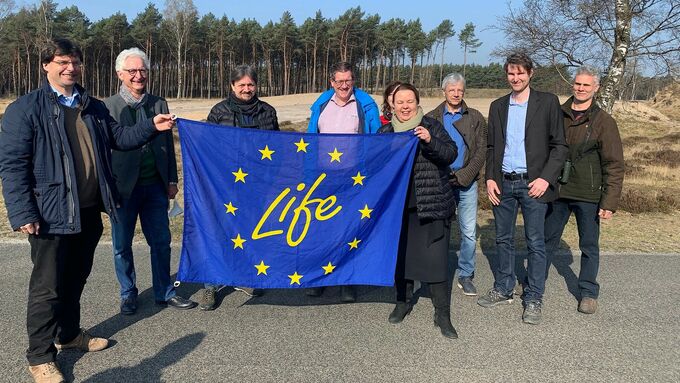main content
News
06.04.2022
Environment Minister Ursula Heinen-Esser visited LIFE IP action in nature reserve ‘Brachter Wald’ in Brüggen
In bright sunshine, North Rhine-Westphalia’s Environment Minister Ursula Heinen-Esser paid a visit to the ‘Atlantic Region DE’ in the nature reserve ‘Brachter Wald’ in the district of Viersen on 28 March 2022. The area is of state-wide importance due to numerous endangered and rare species such as the European nightjar. The one-hour tour in a minibus took place at the invitation of the Friends of the Biological Station ‘Krickenbecker Seen’.
Within the framework of the LIFE IP, in the winter half-year 2020/2021, ‘dry sand heaths with Calluna and Genista’ (habitat type 2310) and ‘inland dunes with open Corynephorus and Agrostis grasslands’ (habitat type 2330) were restored and rare ‘species-rich Nardus grasslands’ (habitat type 6230) were enlarged on an area of about seven hectares in the nature reserve Brachter Wald by removing pine trees and then removing the topsoil, which was mostly overgrown with grass. In the neighbouring nature reserve ‘Heidemoore’, ‘European dry heaths’ (habitat type 4030) had already been restored in addition to the two dune habitat types 2310 and 2330. The open sandy areas now offer ideal habitats for smooth snakes and sand lizards.
The group got off the bus at three points to visit the LIFE IP action areas and viewpoints. There, explanations were given on the measures implemented and their importance for the area. The minister was impressed by the implementation of the measures as well as the beauty and vastness of the nature reserve. The representatives of the biological station were pleased and grateful for the possibility of implementing measures within the framework of the LIFE IP and the associated further development of the protected area.
On the way, the participants were also able to spot some fallow deer, which, along with Koniks and sheep, contribute to the maintenance of the area.




